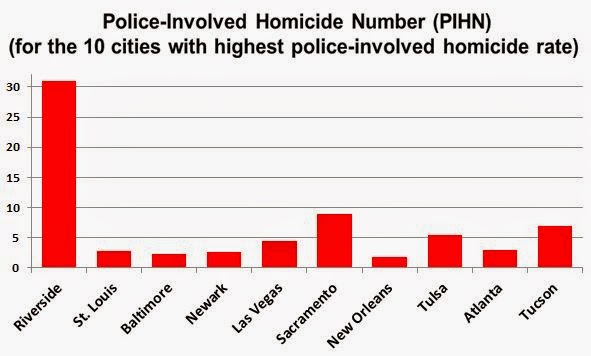I’m going to wait till more is known before saying more. But here is yet another — I won’t say “common” but I will say “too common” — shootings that perhaps should but won’t become big national news. There probably won’t be protests. There won’t be unrest. But did police really break into the house of Jack Jacquez and shoot…
Black are 4 times more likely than whites to be killed by police
[Update: Cut to the chase. You might just want to read my summary post.] Related to the “not 21 times” previous post, I received a tweet from one of the authors: “Differences in our methodologies: you count Hispanic homicides as white… deflate the results.” So back to running stats for me. But there’s a problem in that the UCR homicide…
Black teens are not 21 times more likely than whites to be shot and killed by police
[Update: Cut to the chase. You might just want to read my summary post.] One of my liberal de Blasio-loving not-so-fond-of-cops friend send me an email with the subject “you gotta check yo facts” and a link to ProPublica: “Young black males in recent years were at a far greater risk of being shot dead by police than their white…
Police-involved shootings and hispanics
I asked Jim, my Dominican-born Austin-raised San Francisco-living white friend, why he thought so many Californian cities were high on my PIHN list. He thought for a very few short seconds and answered, “because hispanics aren’t violent but police think they are.” I love over-generalizations and stereotypes that could very well be true. So I got black and hispanic percentages…
The PIHN Winners
The winner, still by far, is Riverside, CA. But sneaking into second place is Mesa, Arizona, the only non-Californian city in the top 6. Here’s the top 20 with the PIHN. All 20 are west of the Mississippi: Riverside: 31 Mesa: 14 San Diego: 12 Sacramento: 9 Bakersfield: 8 Seattle: 8 Portland: 8 Albuquerque: 7 Fresno: 7 Tucson: 7 San…
What’s up, Riverside?
The city of Riverside, California appears to be, by far, the city in which police are most likely to commit justifiable homicide. I listed a rough rank order of cities in my previous post. Riverside is almost 50 percent higher than the next highest cities, St. Louis and Baltimore. (Even more so if one takes into account Riverside’s population gains…
PIHN (police-involved homicide number)
I’ve invented a statistic (and acronym) called PIHN (pronounced “pin”). It stands for “Police-Involved Homicide Number.” PIHN looks at police-involved homicides but takes a city’s violence into account. PIHN assumes a (very questionable) direct relationship between homicides in a city and the number police-involved homicides one might expect. A high PIHN means that there are more police-involved homicides for a…
Bang bang, they shoot you down
The data on police-involved shootings are notoriously bad (that’s a link to Jon Stewart worth clicking on!). And yet, at least we kind of know which data are missing. That makes the data not as bad as you might think. At least when it comes to police-involved justifiable homicides (for shootings, we don’t know. But if you multiply homicides by…
The Felony Rush
The tenth and perhaps last in a series from Sgt. Adam Plantinga’s excellent 400 Things Cops Know: Street-Smart Lessons from a Veteran Patrolman: Once the fleeing vehicle has finally come to a halt, your training dictates that you then conduct a high risk stop. You park your squad car in a position of tactical advantage and order the occupants out…
Rates help us compare
This is the second of two postson basic math. Use rates when you want compare something in groups of different sizes. Say New York City has 400 homicides a year. Say Baltimore City has 300 homicides. Is New York more dangerous than Baltimore because New York has more homicides. No. Because New York is much larger. But the homicide numbers…

